Intravenous Equipment Market Overview
As per MRFR analysis, the Intravenous Equipment Market Size was estimated at 31.94 (USD Billion) in 2024. The Intravenous Equipment Market Industry is expected to grow from 33.16 (USD Billion) in 2025 to 46.47 (USD Billion) till 2034, at a CAGR (growth rate) is expected to be around 3.82% during the forecast period (2025 - 2034).
Key Intravenous Equipment Market Trends Highlighted
The Intravenous Equipment Market is experiencing several notable trends driven by various factors. A key market driver is the increasing prevalence of chronic diseases, which leads to a higher demand for intravenous therapy. Additionally, the rising elderly population requires more healthcare services, adding to the need for intravenous equipment. Advances in technology are also playing a significant role, as innovations in devices improve safety and efficacy in patient care. Opportunities exist for market participants to expand their product offerings, especially in developing regions where healthcare infrastructure is evolving.
There is also potential in enhancing the integration of smart technologies within intravenous equipment to optimize patient monitoring and medication delivery.As healthcare providers increasingly focus on patient-centric solutions, there is a growing demand for equipment that improves the overall patient experience and reduces the likelihood of complications. In recent times, there is a noticeable shift toward single-use devices to minimize the risk of infections, aligning with stricter regulatory standards. The trend of customization in intravenous equipment is gaining traction as healthcare facilities aim to tailor solutions to meet specific patient needs.
Moreover, the rise of telemedicine has led to more remote patient monitoring, creating a demand for portable intravenous systems. This evolution reflects a broader drive toward more comprehensive, efficient, and safer healthcare solutions, emphasizing the importance of intravenous equipment in modern medical practices.As these trends continue to develop, stakeholders in the Intravenous Equipment Market are likely to see shifts in demand and opportunities for growth.

Source: Primary Research, Secondary Research, Market Research Future Database and Analyst Review
Intravenous Equipment Market Drivers
Rising Prevalence of Chronic Diseases
The Intravenous Equipment Market is witnessing significant growth driven by the increasing prevalence of chronic diseases, including diabetes, cancer, and cardiovascular diseases. As these conditions require long-term treatment, intravenous therapy becomes a critical component of patient care. With advancements in medical technology and devices, there is a growing trend toward the use of intravenous equipment in both hospital and outpatient settings.This increased reliance on IV therapy is pushing healthcare providers to invest in new and improved intravenous equipment to enhance patient outcomes and ensure efficient administration of medications and fluids.
Additionally, the growing elderly population, which is more susceptible to various health conditions, contributes to the rising demand for intravenous treatments. The Intravenous Equipment Market Industry is thus positioned for sustained growth as healthcare systems adapt to meet the needs of patients with chronic illnesses.Furthermore, the focus on developing advanced intravenous systems and accessories that offer ease of use and improved safety is likely to bolster market expansion. The transition towards home healthcare and outpatient services is also encouraging the adoption of user-friendly intravenous devices that can be utilized outside traditional settings, further broadening the market landscape.
Technological Advancements in IV Devices
Technological innovations in intravenous equipment are transforming the Intravenous Equipment Market Industry significantly. The introduction of smart IV systems, infusion pumps, and integrated monitoring devices has improved the safety and efficiency of intravenous therapies. These advancements enable healthcare providers to manage patient care better, reduce medication errors, and enhance the overall quality of treatment. As technology continues to evolve, there is an increasing focus on developing products that cater to the growing demand for precision in drug delivery and personalized medicine.
Growth of the Healthcare Sector
The expansion of the global healthcare sector is a fundamental driver of the Intravenous Equipment Market Industry. Increased government spending, rising health awareness, and improving access to medical facilities contribute to the overall growth of healthcare services. Enhanced healthcare infrastructure, particularly in emerging economies, is driving up the demand for advanced intravenous equipment. With more hospitals and clinics being established, the need for reliable and efficient IV systems becomes paramount.
Intravenous Equipment Market Segment Insights
Intravenous Equipment Market Type Insights
The Intravenous Equipment Market exhibits notable diversity within its Type segment, characterized by various essential components, including Infusion Pumps, IV Catheters, IV Administration Sets, Needles, and IV Containers.
In 2023, the market for Intravenous Equipment was valued at approximately 29.63 billion USD, reflecting a steady demand for intravenous solutions in healthcare settings. The Infusion Pumps segment leads with a market value of 8.14 billion USD, anticipated to grow to 11.3 billion USD by 2032, showcasing the critical role of these devices in delivering precise medication and fluids to patients.This segment holds a majority stake, clearly dominating the market due to its essential function in therapeutic applications.
Following closely, the IV Catheters segment recorded a market value of 6.87 billion USD in 2023 and is projected to reach 9.9 billion USD by 2032, indicating their significant role in patient care by facilitating easy access to veins for medication administration.
IV Administration Sets contributed a solid value of 5.62 billion USD in 2023, with expected growth to 7.9 billion USD by 2032. These sets are vital in the safe and efficient administration of fluids, thereby further ensuring patient safety and comfort.On the other hand, the Needles segment held a value of 4.89 billion USD in 2023, projected to rise to 6.8 billion USD by 2032. This segment, while smaller, remains essential as needles serve as fundamental tools in various medical procedures.
Lastly, IV Containers, valued at 4.11 billion USD in 2023 and expected to reach 5.6 billion USD in 2032, are crucial in safely storing and delivering IV solutions. Each of these components not only contributes significantly to the Intravenous Equipment Market revenue but also highlights the increasing reliance on intravenous therapies in modern medical practice.However, the sector faces challenges such as regulatory hurdles and concerns regarding the safety and efficacy of intravenous products. Overall, the Intravenous Equipment Market segmentation underscores distinct opportunities for innovation and expansion within a dynamic market landscape.

Source: Primary Research, Secondary Research, Market Research Future Database and Analyst Review
Intravenous Equipment Market Application Insights
The Intravenous Equipment Market is primarily driven by applications that span critical healthcare needs. In 2023, the market was valued at 29.63 USD billion and was poised for growth due to increasing demand in areas such as chemotherapy, pain management, antibiotic therapy, fluid resuscitation, and nutritional support. Each application plays a crucial role; for instance, chemotherapy is essential for cancer treatment, necessitating reliable intravenous systems for administration. Pain management continues to see significant use of intravenous equipment, providing effective relief in various medical conditions.
Antibiotic therapy is vital in combating infections, hence increasingly relying on intravenous methods to ensure swift delivery. Fluid resuscitation is significant in emergency care, particularly in trauma situations, while nutritional support is a growing area, especially in patients unable to consume food orally. These dynamics showcase the vital segments within the Intravenous Equipment Market, and the market is projected to reach 41.5 USD billion by 2032, reflecting an evolving landscape with opportunities for growth driven by technological advancements and a rising prevalence of chronic diseases as indicated by Intravenous Equipment Market data and statistics.
Intravenous Equipment Market End-Use Insights
The Intravenous Equipment Market has a well-defined segmentation based on End Use, which plays a crucial role in driving its revenue potential. In 2023, the overall market was valued at 29.63 billion USD, with hospitals being a major contributor, benefiting from the high demand for intravenous therapies in critical and acute care settings. Ambulatory Surgical Centers also hold a significant share, offering convenience for patients requiring same-day procedures that often involve IV administration. Home Care Settings are an emerging area, driven by the growing trend of providing healthcare services in a patient's own home, promoting comfort and reducing hospital stays.
Specialty Clinics contribute uniquely by catering to specific patient populations, such as oncology or diabetes, where intravenous treatments are essential. The Intravenous Equipment Market statistics show that as healthcare continues to evolve, these segments present numerous opportunities for growth, driven by an increase in chronic diseases and advancements in IV therapy technologies. Additionally, the market faces challenges such as regulatory requirements and cost pressures, which may influence the overall dynamics but also pave the way for innovation and improvements in service delivery.
Intravenous Equipment Market Technology Insights
The market’s segmentation showcases the prominence of various systems, with the Electromechanical Pumps representing a substantial portion due to their precision and efficiency in delivering medication. Gravity Infusion Systems continue to be widely utilized, especially in settings where straightforward administration is necessary, allowing for effective and cost-efficient care in many healthcare environments.Meanwhile, Smart IV Therapy Systems are increasingly gaining importance, integrating technology and connectivity features that enhance patient safety and treatment efficacy. This trend towards automation and smart solutions is reshaping the landscape of the industry.
The expected growth in the Intravenous Equipment Market data highlights an evolving market that responds to clinician needs and patient safety, providing ample opportunities for innovation in design and function. As technology continues to advance, the Intravenous Equipment Market Statistics suggest that these equipment types will play a crucial role in optimizing intravenous therapies and improving patient outcomes.
Intravenous Equipment Market Regional Insights
The Intravenous Equipment Market is valued at 29.63 USD Billion in 2023 and is set for considerable growth within the regional segmentation. North America dominates this market with a substantial valuation of 12.5 USD Billion, reflecting its majority holding and advanced healthcare infrastructure, projected to reach 18.0 USD Billion by 2032. Europe follows closely, with a significant valuation of 8.5 USD Billion in 2023, which is anticipated to grow to 11.5 USD Billion, driven by increasing chronic diseases and an aging population.
The APAC region is valued at 6.5 USD Billion and is projected to grow to 8.5 USD Billion, attributed to rising healthcare investments and demand for intravenous therapies.South America and MEA represent smaller segments, valued at 1.5 USD Billion and 0.6 USD Billion, respectively in 2023, with growth to 2.5 USD Billion and 1.0 USD Billion by 2032. These regions offer opportunities for market expansion led by improving healthcare access and rising disposable incomes. The Intravenous Equipment Market statistics highlight varied growth drivers, but the challenges of regulatory hurdles and competition remain prevalent across all regions.

Source: Primary Research, Secondary Research, Market Research Future Database and Analyst Review
Intravenous Equipment Market Key Players and Competitive Insights
The Intravenous Equipment Market is characterized by a dynamic competitive landscape marked by the presence of several key players that strive to innovate and enhance their product offerings to cater to the evolving needs of healthcare providers and patients. This market encompasses a range of products that are essential for intravenous therapy, including IV bags, catheters, and infusion pumps, and it is driven by factors such as a growing prevalence of chronic diseases, advancements in technology, and an increasing need for effective patient management systems.
The competitive insights in this sector reveal a continuous emphasis on product development, strategic collaborations, mergers, and acquisitions, enabling companies to expand their market reach while enhancing patient safety and therapeutic outcomes.
Braun Melsungen holds a significant position in the Intravenous Equipment Market, bolstered by its extensive product portfolio and a strong focus on innovation. The company's strengths lie in its comprehensive range of IV solutions, which cater to various medical needs, making it a reliable partner for healthcare institutions. B. Braun Melsungen invests heavily in research and development, ensuring that the latest technologies and best practices are incorporated into their products. Furthermore, the company's commitment to quality and safety is evident in its rigorous adherence to regulatory standards and certifications.
This focus not only instills confidence among healthcare professionals but also positions B. Braun Melsungen as a leader in the market, consistently addressing challenges related to intravenous therapy while improving patient care.
Cardinal Health is another prominent entity in the Intravenous Equipment Market, recognized for its comprehensive distribution network and extensive range of intravenous products. The company benefits from a robust infrastructure that allows it to efficiently deliver essential IV supplies to healthcare providers. Cardinal Health's unique strength lies in its ability to integrate analytics and technology into its operations, enabling healthcare facilities to optimize their supply chains and improve patient outcomes. The company's focus on custom solutions further enhances its value proposition, allowing it to cater to the specific needs of different healthcare providers.
By continuously enhancing its product offerings and leveraging its market presence, Cardinal Health plays a crucial role in shaping the future of intravenous therapy while maintaining high standards of quality and reliability within the industry.
Key Companies in the Intravenous Equipment Market Include
- Braun Melsungen
- Cardinal Health
- IV Solutions
- Medtronic
- Vygon
- Terumo Corporation
- Nipro Corporation
- R. Bard
- Fresenius Kabi
- Baxter International
- Haemonetics
- AMEDTEC Medizintechnik
- AngioDynamics
- MediPoint
- Smiths Medical
Intravenous Equipment Industry Developments
-
Q2 2025: BD Launches HemoSphere Alta Platform with AI-Driven Decision Support for Critical-Care Hemodynamics BD announced the launch of its HemoSphere Alta platform, which integrates AI-driven decision support to enhance critical-care hemodynamics monitoring, expanding its intravenous equipment portfolio.
-
Q2 2025: Teleflex Secures FDA 510(k) Clearance for the AC3 Range Intra-Aortic Balloon Pump Teleflex received FDA 510(k) clearance for its AC3 Range intra-aortic balloon pump, a device used in intravenous therapy for critical cardiac care.
-
Q1 2025: Merck’s subcutaneous pembrolizumab met non-inferiority versus IV dosing in Phase 3 trial Merck announced positive Phase 3 trial results for subcutaneous pembrolizumab, demonstrating non-inferiority compared to intravenous dosing, which may impact future IV equipment demand.
Intravenous Equipment Market Segmentation Insights
Intravenous Equipment Market Type Outlook
- Infusion Pumps
- IV Catheters
- IV Administration Sets
- Needles
- IV Containers
Intravenous Equipment Market Application Outlook
- Chemotherapy
- Pain Management
- Antibiotic Therapy
- Fluid Resuscitation
- Nutritional Support
Intravenous Equipment Market End-Use Outlook
- Hospitals
- Ambulatory Surgical Centers
- Home Care Settings
- Specialty Clinics
Intravenous Equipment Market Technology Outlook
- Electromechanical Pumps
- Gravity Infusion Systems
- Smart IV Therapy Systems
Intravenous Equipment Market Regional Outlook
- North America
- Europe
- South America
- Asia-Pacific
- Middle East and Africa
| Report Attribute/Metric |
Details |
|
Market Size 2024
|
31.94 (USD Billion)
|
|
Market Size 2025
|
33.16 (USD Billion)
|
|
Market Size 2034
|
46.47 (USD Billion)
|
|
Compound Annual Growth Rate (CAGR)
|
3.82 % (2025 - 2034)
|
|
Report Coverage
|
Revenue Forecast, Competitive Landscape, Growth Factors, and Trends
|
|
Base Year
|
2024
|
|
Market Forecast Period
|
2025 - 2034
|
|
Historical Data
|
2020 - 2024
|
| Market Forecast Units |
USD Billion |
| Key Companies Profiled |
B. Braun Melsungen, Cardinal Health, IV Solutions, Medtronic, Vygon, Terumo Corporation, Nipro Corporation, C.R. Bard, Fresenius Kabi, Baxter International, Haemonetics, AMEDTEC Medizintechnik, AngioDynamics, MediPoint, Smiths Medical |
| Segments Covered |
Type, Application, End Use, Technology, Regional |
| Key Market Opportunities |
Telehealth integration for IV therapy, Growth in home healthcare services, Advanced smart IV delivery systems, Rising demand for infection control, Expanding market in emerging economies |
| Key Market Dynamics |
growing chronic disease prevalence, technological advancements, increasing geriatric population, rising demand for home healthcare, regulatory compliance challenges |
| Countries Covered |
North America, Europe, APAC, South America, MEA |
Frequently Asked Questions (FAQ):
The Intravenous Equipment Market is expected to be valued at 46.47 USD Billion by 2034.
The projected CAGR for the Intravenous Equipment Market from 2025 to 2034 is 3.82%.
North America is expected to hold the largest market share at 18.0 USD Billion by 2034.
The estimated market size for Infusion Pumps is expected to be 11.3 USD Billion by 2032.
Key players in the Intravenous Equipment Market include B. Braun Melsungen, Cardinal Health, Medtronic, and Fresenius Kabi.
The market value for IV Catheters is projected to reach 9.9 USD Billion by 2032.
In 2023, the Intravenous Equipment Market is valued at 29.63 USD Billion.
The expected market size for Europe in the Intravenous Equipment Market by 2032 is 11.5 USD Billion.
Infusion Pumps are projected to see notable growth, with an expected increase to 11.3 USD Billion by 2032.
The projected market value for IV Administration Sets is expected to be 7.9 USD Billion by 2032.

















